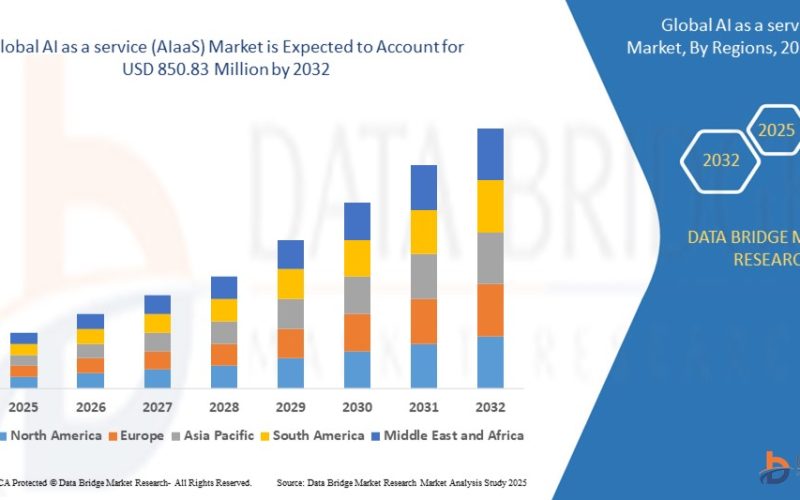Introduction
In the evolving landscape of artificial intelligence, the demand for scalable, cost-effective, and accessible solutions is at an all-time high. With the advent of AI as a Service (AIaaS), companies of all sizes can now include AI capabilities without having to spend a fortune on specialised personnel or costly infrastructure. For startups and enterprises alike, AIaaS offers a shortcut to innovation, enabling them to deploy machine learning, natural language processing, image recognition, and other AI functions seamlessly. Here, we’ll examine how to use AIaaS to create scalable AI solutions and highlight the best practices to guarantee success.
Definition
AI as a Service (AIaaS) is a cloud-based offering that provides access to artificial intelligence tools and capabilities – such as machine learning, natural language processing, and computer vision – through APIs or platforms, without requiring users to build or maintain their own AI infrastructure. It enables businesses to integrate AI into their applications easily and cost-effectively.
What is AI as a Service (AIaaS)?
AIaaS is a cloud-based solution that offers pre-built services and APIs for access to AI tools and frameworks. Like Software as a Service (SaaS), AIaaS companies oversee model maintenance, scalability, and back-end infrastructure. Instead of creating the technology from the ground up, this enables organisations to concentrate on utilising it.
AIaaS includes services such as:
- Machine Learning (ML) platforms
- Chatbots and virtual assistants
- Natural Language Processing (NLP)
- Computer vision APIs
- Predictive analytics
- Robotic Process Automation (RPA)
Amazon Web Services (AWS) AI, Microsoft Azure AI, Google Cloud AI, IBM Watson, and OpenAI are well-known suppliers of AIaaS.
Why Use AIaaS for Building Scalable AI Solutions?
Before diving into how to build scalable solutions, it’s important to understand why AIaaS is ideal:
Reduced Cost: No need to invest in high-end GPUs or hire large AI teams.
Faster Time to Market: Quick integration of pre-trained models and APIs is possible.
Scalability: Cloud providers offer elastic compute power, enabling applications to scale based on demand.
Maintenance-Free: Infrastructure, updates, and model tuning are handled by the provider.
Experimentation Friendly: Pay-as-you-go models allow experimentation without long-term commitment.
Steps to Build Scalable AI Solutions Using AIaaS
1. Define the Problem Clearly:
The business challenge that AI is supposed to solve should be defined before implementation begins. Is it automating customer service? Predicting churn? Enhancing search results?
A clearly scoped problem helps you choose the right tools, metrics, and AIaaS platforms.
2. Choose the Right AIaaS Provider:
Each provider has its strengths:
- AWS AI: Offers robust ML tools like Amazon SageMaker and Rekognition for image/video analysis.
- Google Cloud AI: known for its sophisticated NLP and AutoML features.
- Microsoft Azure AI: Excellent for enterprise integration and pre-built cognitive services.
- IBM Watson: Great for healthcare and enterprise applications.
- OpenAI: Best for advanced language models (like ChatGPT) and generative AI.
Evaluate based on your needs, budget, and desired functionality.
3. Prepare and Clean Your Data:
Even if you’re using pre-trained models, data quality matters. Ensure your data is:
- Cleaned and formatted
- Balanced (for classification problems)
- Annotated (if required for fine-tuning)
Many AIaaS providers offer data preparation and labeling tools as part of their platform.
4. Use Pre-Built Models or Train Custom Ones:
AIaaS platforms offer two primary approaches:
- Pre-trained APIs: For tasks like sentiment analysis, object detection, or speech-to-text, pre-built models are often sufficient.
- Custom Training: If your use case is niche or requires domain-specific knowledge, use AutoML or custom training features offered by providers like SageMaker or Google AutoML.
For scalability, custom models can still be implemented using the AIaaS infrastructure.
5. Build an API-Based Architecture:
To ensure scalability, your application should interact with AI models via APIs. This decouples the AI component from the application logic, making it easier to update, scale, or swap providers.
Example:
- Your web app sends an image to the AIaaS API.
- The API returns a result (e.g., “Dog” with 95% confidence).
- Your app displays the response or takes further action.
6. Integrate with Business Workflows:
AI is only useful if it’s integrated seamlessly into your existing workflows. Whether it’s sales, marketing, or customer support, the AI service should trigger or enhance decisions automatically.
For example:
- A chatbot powered by OpenAI’s GPT can directly assist users on your website.
- Predictive analytics can feed insights into CRM tools to assist sales reps.
7. Ensure Security and Compliance:
AIaaS involves data transfer and possibly sensitive information. Ensure:
- When data is in transit and placed at rest, it is encrypt
- You comply with GDPR, HIPAA, or other relevant regulations.
- You use role-based access controls and API authentication (OAuth, tokens).
Most major providers have compliance certifications and tools to help manage this.
8. Monitor and Optimize:
Scalability isn’t just about performance under load—it’s also about reliability and accuracy over time. Monitor:
- API latency and error rates
- Model performance metrics (accuracy, F1 score, etc.)
- Usage patterns to scale resources proactively
Tools like AWS CloudWatch, Azure Monitor, or third-party services like Datadog can be used for this.
9. Plan for Continuous Improvement:
AI models may degrade over time due to changes in user behavior or market conditions. Use feedback loops to:
- Retrain models periodically
- Incorporate real-world usage data
- Update parameters and algorithms
AIaaS platforms often include model lifecycle management features to streamline this process.
Applications of Scalable AI Solutions with AIaaS in the Real World
- Customer Support: Deploying chatbots using Azure Bot Services or OpenAI’s GPT-4 for 24/7 customer assistance.
- Retail Recommendations: Using Google Cloud’s Recommendation AI to personalize shopping experiences.
- Fraud Detection: Utilising AWS SageMaker to identify irregularities in financial transactions.
- Healthcare Diagnostics: IBM Watson used for oncology decision support in hospitals.
These examples show how different industries benefit from AIaaS by building scalable and domain-specific solutions without reinventing the wheel.
Challenges to Consider
Although AIaaS makes strong tools easier to access, there are challenges:
- Vendor Lock-in: Switching providers can be difficult once integrated deeply.
- Data Privacy Concerns: Sensitive data should be handled carefully to avoid breaches.
- Model Explainability: Many pre-built AI models are “black boxes.” In regulated industries, this can be a problem.
Addressing these challenges early in the development process is key to long-term scalability.
Future Trends in AIaaS
Rise of Domain-Specific AIaaS:
AIaaS providers are moving toward offering industry-specific solutions – such as healthcare diagnostics, legal document processing, and retail analytics, enabling businesses to adopt tailored AI without custom development.
Integration of Generative AI:
With the success of models like GPT-4 and DALL·E, AIaaS platforms are rapidly integrating generative AI capabilities. This will empower businesses to automate creative tasks like content generation, code writing, and image design at scale.
Low-Code and No-Code AI Platforms:
To democratize AI further, future AIaaS offerings will emphasize low-code/no-code tools. These platforms will allow non-technical users to build and deploy AI applications using drag-and-drop interfaces and simple configuration steps.
Federated and Edge AI:
To address privacy and latency concerns, scalable AI solutions will increasingly adopt federated learning and edge AI models – allowing AI processing to occur locally on devices while maintaining centralized intelligence.
Transparent and Ethical AI:
As regulations evolve, there will be a stronger focus on explainable AI, bias mitigation, and compliance tools embedded within AIaaS platforms to ensure responsible AI adoption at scale.
Growth Rate of AI as a Service (AIaaS) Market
According to Data Bridge Market Research, the size of the global AI as a service (AIaaS) market was estimated at USD 91.00 million in 2024 and is projected to grow at a compound annual growth rate (CAGR) of 32.20% to reach USD 850.83 million by 2032.
Learn More: https://www.databridgemarketresearch.com/reports/global-ai-as-a-service-aiaas-market
Conclusion
AI as a Service enables companies to innovate more quickly, intelligently, and effectively. By leveraging the scalability, flexibility, and low entry barrier of AIaaS platforms, organizations can transform how they operate and compete in the digital age. From enhancing customer experiences to optimizing internal processes, scalable AI solutions are no longer a luxury – they’re a necessity. And thanks to AIaaS, they’re more accessible than ever.












